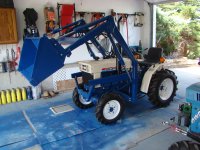EddieWalker
Epic Contributor
I think people confuse the brakes on their car or truck with the hydraulic system on a tractor. In a car, there is nowhere for the fluid to go, so if there is air in the lines, it remains there and you have mushy brakes until you get rid of the air by bleeding the lines. On a tractor, the hydraulic fluid travels around the system, through filters and into the storage tank. This movement of the fluid through the lines forces any air that might be in the lines, out of the lines. If the tank if full, any air that was in there goes to the tank, but since the intake line from the tank is below the level of the fluid, no air can come back into the line.
As for the Original Posters question, his seals are worn on his cylinders. Probably both since it's so loose he can move it with his hands. Deere should have a replacement kit that you can do it yourself. On my larger cylinders, I just have a guy who specializes in cylinder rebuilds do it for me for a hundred bucks plus materials. I just take off the cylinder and bring it to his shop.
It will only get worse, and you have to replace the seals. If you wait too long, some damage to the cylinder wall may occur, but that's pretty rare.
Eddie
As for the Original Posters question, his seals are worn on his cylinders. Probably both since it's so loose he can move it with his hands. Deere should have a replacement kit that you can do it yourself. On my larger cylinders, I just have a guy who specializes in cylinder rebuilds do it for me for a hundred bucks plus materials. I just take off the cylinder and bring it to his shop.
It will only get worse, and you have to replace the seals. If you wait too long, some damage to the cylinder wall may occur, but that's pretty rare.
Eddie


